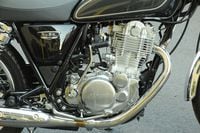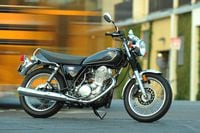Search “café racer” on Craigslist in any major US city and you’ll find dozens of listings, more than a few of which are being offered as non-running projects. Demand is fueled by young, hip riders who are hungry for retro bikes. But, as it turns out, owning a bona fide vintage ride is usually a major hassle. Keeping a 40-year-old machine in good running order can be a challenge, which partly explains why “modern retro” bikes—with EFI and electronic ignition—are so popular right now.
The SR has the traditional UJM look nailed, but this bike isn't just trying to look vintage—it is vintage. In its home market of Japan, the SR has been in almost continuous production since 1978, and save for the addition of emissions paraphernalia and EFI (it had a carburetor up until 2007), has rolled through the decades essentially unchanged. It's powered by a throwback of a motor: a bare-bones 399cc, air-cooled, SOHC, two-valve thumper. Steel fenders, 18-inch wheels, and fork gaiters are all straight from the '70s, as is the abundance of chrome complemented by an equal amount of gloss-black paint. Through the years, Yamaha wisely didn't change the SR much.
The only way to bring the SR to life is to kick it over. That’s right, this bike is kick start only. Talk about a throwback! The procedure is made easier thanks to a handlebar-mounted decompression lever, and fuel injection means the motor fires immediately. The SR thumps pleasantly at idle, shaking with enough vigor and mechanical noise to remind you that you’re on a machine. Good thing, because the muffler emits little evidence of the combustion process. This thing is whisper quiet.
While it resembles a café racer, speed is not the SR’s forte. The SR has a stone-simple, low-displacement engine in a very mild state of tune, and it behaves that way when you twist the throttle, building revs slowly and deliberately. Acceleration is decent in the lower gears and the bike is plenty quick for around-town riding, but it struggles to attain highway speeds, and vibrates like a palm sander above 4,500 rpm. These are pains suffered by many small-displacement bikes, though, and it’s worth remembering that the SR wasn’t designed for extended highway travel, but as a city bike and play thing.
As an urban bop-about and short-range commuter, the SR400 is a treat. As Motorcyclist staffers writing about the original bike in 1978 put it, the SR is "traditionally slim throughout, from the narrow and compact engine cases up through the nicely tapered fuel tank." The narrow, firm bench seat is just 30.9 inches off the deck, and with a claimed curb weight of just 384 pounds the Yamaha is easy to handle and quick to respond to steering inputs. The SR's ergonomics reflect the UJM style of the '60s and '70s, with footpegs that are positioned directly below your butt and a slightly pulled-back handlebar that results in a comfortably upright riding position.
That torquey single makes getting off the line a no-fuss affair—this is one of those bikes that allows you to let the clutch out at idle in first gear and be underway. At lower rpm, the bike thumps along with adequate if not exciting power that remains consistently adequate throughout the rev range. But the bike begins to shake busily as the revs rise, and vibrates uncomfortably at higher rpm. The sweet spot is right at 4,000 rpm, corresponding to 55 mph in top (fifth) gear, which, some of you may recall, was the national speed limit in the ‘70s and ‘80s. At 60 mph or below, the SR is fairly smooth and surely efficient—Yamaha suggests the little bike can net 66 mpg, which makes this one cool and fuel-efficient way to get around.
Suspension is basic, just like it was back in the day. The fork is softly sprung—you can push it to the bottom of the stroke with a firm shove while standing over the bike—but there’s adequate damping in both directions of travel so the ride quality is pretty good on rougher city streets. The springs on the shocks are stouter than those in the fork, so the SR is well equipped to carry a passenger. Rear spring preload is adjustable. The rear drum brake is useful but predictably vague, while the single front disk is plenty effective—you just have to use it assertively. Overall, the SR400 is a fine little bike, mechanically sound and terrifically styled. The silent question is how many Yamaha will sell at a hefty $5,990, which is fairly steep for such a simple, no-frills machine. But Yamaha likely scanned the Craigslist ads, saw what people were selling their non-running CB350s and RD400s for, and figured six grand for a brand-new and thoroughly reliable retro-styled bike was reasonable. You can almost see Yamaha’s thinking, since the 400 slots in between the base Triumph Bonneville ($7,899) and Suzuki’s similarly retro TU250X ($4,399). Or, maybe that’s just what it costs to make a profit on the little made-in-Japan SR.
Riders who aren’t immediately swayed by the SR’s retro profile will notice that It doesn’t have a gear position indicator, clock, fuel gauge, or any of the other features we’ve come to expect from modern motorcycles—even entry-level machines. But that's kind of the point. The SR is a fundamental motorcycle, and if you're after that essential vintage-bike look and feel without the constant upkeep, the SR400 may be the bike for you.





















/cloudfront-us-east-1.images.arcpublishing.com/octane/G4MG6OUCJNBSHIS2MVVOTPX65E.jpg)
/cloudfront-us-east-1.images.arcpublishing.com/octane/IIGGWFOTOJGB7DB6DGBXCCMTDY.jpg)
/cloudfront-us-east-1.images.arcpublishing.com/octane/QSTCM6AVEZA5JJBUXNIQ3DSOF4.jpg)
/cloudfront-us-east-1.images.arcpublishing.com/octane/U4I7G625B5DMLF2DVIJDFZVV6M.jpg)
/cloudfront-us-east-1.images.arcpublishing.com/octane/B6XD6LS6IVCQPIU6HXDJSM3FHY.jpg)
/cloudfront-us-east-1.images.arcpublishing.com/octane/ICL63FEDDRDTTMINYICCEYGMDA.jpg)
/cloudfront-us-east-1.images.arcpublishing.com/octane/FCGZHQXRBZFLBAPC5SDIQLVF4I.jpg)
/cloudfront-us-east-1.images.arcpublishing.com/octane/WNOB6LDOIFFHJKPSVIWDYUGOPM.jpg)

/cloudfront-us-east-1.images.arcpublishing.com/octane/X33NU3E525ECRHXLNUJN2FTRKI.jpg)
/cloudfront-us-east-1.images.arcpublishing.com/octane/6KKT5NNL2JAVBOXMZYS5ZO76YA.jpg)
/cloudfront-us-east-1.images.arcpublishing.com/octane/J5RKG5O455GMPGQRF2OG6LRT7A.jpg)
/cloudfront-us-east-1.images.arcpublishing.com/octane/GX2CIZKQVRH2TATDM26KFG2DAE.jpg)
/cloudfront-us-east-1.images.arcpublishing.com/octane/ZWIDYSAKQZHD5BHREMQILXJCGM.jpg)
/cloudfront-us-east-1.images.arcpublishing.com/octane/CYUHJZCTSJCH3MRAQEIKXK7SCQ.jpg)
/cloudfront-us-east-1.images.arcpublishing.com/octane/LKOFINY56FCXJCANJ5M7ZDQUBY.jpg)
/cloudfront-us-east-1.images.arcpublishing.com/octane/4NBPDACMWJH63JQYJVK3QRBDZI.jpg)
/cloudfront-us-east-1.images.arcpublishing.com/octane/KKHQHRR3FJGX7H2IPU6RALMWG4.jpg)

/cloudfront-us-east-1.images.arcpublishing.com/octane/5IOFS5JAE5FOXMNA23ZRAVVYUU.jpg)
/cloudfront-us-east-1.images.arcpublishing.com/octane/CGXQ3O2VVJF7PGTYR3QICTLDLM.jpg)

/cloudfront-us-east-1.images.arcpublishing.com/octane/OQVCJOABCFC5NBEF2KIGRCV3XA.jpg)
/cloudfront-us-east-1.images.arcpublishing.com/octane/OPVQ7R4EFNCLRDPSQT4FBZCS2A.jpg)